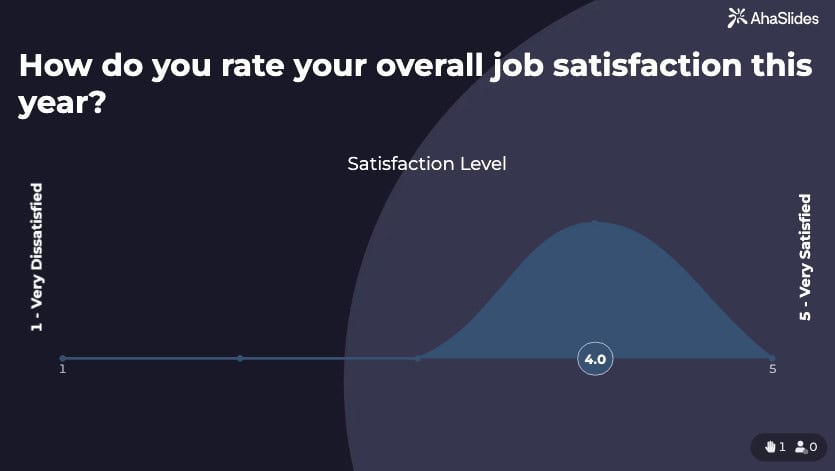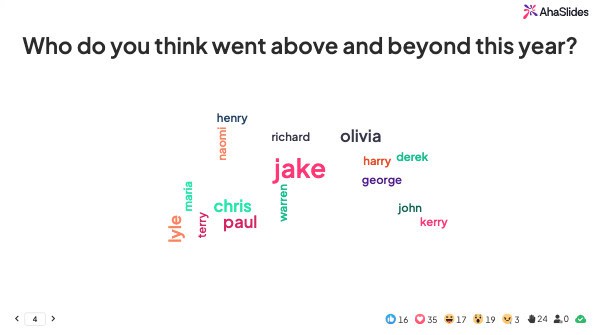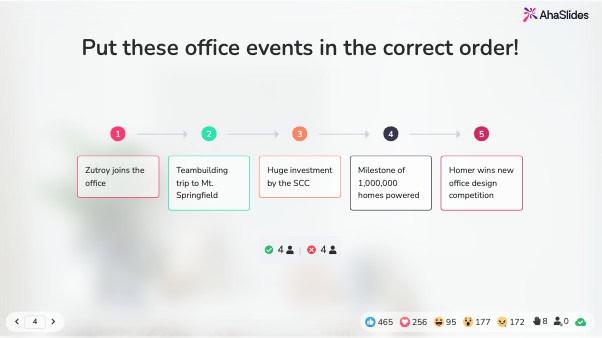Umume organisasi nganggep review pungkasan taun minangka piala sing dibutuhake-olahraga kothak sing ditindakake saben wong ing Desember.
Nanging iki sing ilang: yen rampung kanthi bener, obrolan iki dadi salah sawijining alat sing paling penting kanggo mbukak kunci potensial, nguatake tim, lan ngarahake asil bisnis. Bentenipun review perfunctory lan transformatif ora luwih wektu-iku luwih nyiyapake.
Pandhuan lengkap iki nyedhiyakake kerangka langkah-demi-langkah, 50+ frasa praktis, conto nyata ing konteks sing beda-beda, lan tips pakar kanggo mbantu sampeyan nggawe review pungkasan taun sing drive obrolan migunani lan dandan bisa diukur

Bab lan Paragraf
- Cara nulis review akhir taun: kerangka langkah-langkah
- Conto review pungkasan taun
- 50+ frasa review pungkasan taun
- Kesalahan umum sing kudu dihindari ing review pungkasan taun
- Tinjauan pungkasan taun kanggo manajer: cara nindakake tinjauan sing efektif
- Nggunakake AhaSlides kanggo review akhir taun interaktif
- Pitakonan Paling Sering
Cara nulis review akhir taun: kerangka langkah-langkah
Langkah 1: Klumpukne bahan sampeyan
Sadurunge miwiti nulis, kumpulake:
- Metrik kinerja: Angka penjualan, tingkat penyelesaian proyek, skor kepuasan pelanggan, utawa prestasi sing bisa diukur
- Umpan balik saka wong liya: Tinjauan kanca, cathetan manajer, testimoni klien, utawa umpan balik 360 derajat
- Dokumentasi proyek: Proyek, presentasi, laporan, utawa kiriman sing wis rampung
- Cathetan sinau: Latihan rampung, sertifikasi entuk, katrampilan dikembangake
- Cathetan refleksi: Sembarang cathetan pribadi utawa entri jurnal saka saindhenging taun
Pro tip: Gunakake fitur survey AhaSlides kanggo ngumpulake umpan balik anonim saka kolega sadurunge ditinjau. Iki nyedhiyakake perspektif sing penting sing bisa uga ora sampeyan pikirake.
Langkah 2: Refleksi prestasi
Gunakake metode STAR (Situasi, Tugas, Tindakan, Hasil) kanggo nyusun prestasi sampeyan:
- kahanan: Apa konteks utawa tantangan?
- Task: Apa sing kudu ditindakake?
- Tindakan: Tindakan spesifik apa sing sampeyan tindakake?
- Result: Apa asil sing bisa diukur?
Tuladha kerangka:
- Jumlah impact sampeyan (nomer, persentasi, wektu disimpen)
- Sambungake prestasi menyang tujuan bisnis
- Nyorot wektu kolaborasi lan kepemimpinan
- Tampilake kemajuan lan wutah
Langkah 3: Ngatasi tantangan lan wilayah kanggo dandan
Jujur nanging mbangun: Ngakoni wilayah ngendi sampeyan ngadhepi kangelan, nanging pigura iku minangka kesempatan sinau. Tampilake apa sing wis ditindakake kanggo nambah lan apa sing bakal ditindakake sabanjure.
supaya:
- Nggawe alesan
- Nyalahke wong liya
- Dadi kebacut negatif
- Pernyataan sing ora jelas kaya "Aku kudu nambah komunikasi"
Nanging, dadi spesifik:
- "Aku pisanan berjuang karo ngatur macem-macem tenggat wektu proyek. Aku wiwit ngetrapake sistem pamblokiran wektu lan ningkatake tingkat penyelesaian kanthi 30%.
Langkah 4: Nyetel gol kanggo taun sing bakal teka
Gunakake kritéria SMART:
- Tartamtu: Tujuan sing cetha lan jelas
- Measurable: Metrik sukses sing bisa diukur
- Kabukten: Realistis diwenehi sumber daya lan alangan
- Reporting: Selaras karo peran, tim, lan tujuan perusahaan
- Watesan wektu: Mbusak tenggat wektu lan tonggak sejarah
Goal kategori kanggo nimbang:
- Pangembangan katrampilan
- Kepemimpinan proyek
- Kolaborasi lan kerja tim
- Inovasi lan proses dandan
- Kamajuan majune
Langkah 5: Nyuwun saran lan dhukungan
Dadi proaktif: Aja ngenteni manajer sampeyan menehi umpan balik. Takon pitakonan khusus babagan:
- Wilayah sing bisa tuwuh
- Skills sing bakal nggawe sampeyan luwih efektif
- Kesempatan kanggo tambah tanggung jawab
- Sumber daya utawa latihan sing bakal mbantu

Conto review pungkasan taun
Conto review pribadi pungkasan taun
Konteks: Refleksi individu kanggo pangembangan karir
bagean prestasi:
"Taun iki, aku sukses mimpin inisiatif transformasi digital kanggo departemen layanan pelanggan kita, sing ngasilake wektu respon rata-rata 40% lan nambah 25% skor kepuasan pelanggan. Aku ngatur tim lintas fungsi wolung wong, koordinasi antarane IT, operasi, lan tim layanan pelanggan kanggo njamin implementasine lancar.
Aku uga ngrampungake sertifikasi ing Manajemen Proyek Agile lan ngetrapake metodologi kasebut ing telung proyek utama, nambah tingkat penyelesaian proyek kanthi 20%. Kajaba iku, aku mentoring loro anggota tim junior, sing loro-lorone wis dipromosikan dadi peran senior.
Tantangan lan bagean wutah:
"Awal taun, aku berjuang kanthi ngimbangi pirang-pirang proyek prioritas kanthi bebarengan. Aku ngakoni iki minangka area kanggo pangembangan lan ndhaptar kursus manajemen wektu. Aku wiwit ngetrapake kerangka prioritas sing mbantu aku ngatur beban kerja kanthi luwih efektif.
Gol kanggo taun ngarep:
"1. Pimpin paling ora rong inisiatif lintas departemen kanggo nggedhekake pengaruh lan visibilitas ing saindenging organisasi
- Rampungake pelatihan lanjutan ing analytics data kanggo ndhukung pengambilan keputusan sing didorong data
- Ngembangake katrampilan wicara umum kanthi tampil ing rong konferensi industri
- Njupuk peran mentoring formal ing program bimbingan perusahaan kita "
Dhukungan sing dibutuhake:
"Aku bakal entuk manfaat saka akses menyang alat lan latihan analytics canggih, uga kesempatan kanggo menehi pimpinan senior kanggo ngembangake katrampilan komunikasi eksekutif."
Conto review akhir taun karyawan
Konteks: Evaluasi diri karyawan kanggo review kinerja
bagean prestasi:
"Ing 2025, aku ngluwihi target dodolan kanthi 15%, nutup transaksi regane £ 2.3 yuta dibandhingake karo target £ 2 yuta. Aku entuk iki liwat kombinasi ngembangake hubungan karo klien sing wis ana (sing ngasilake 60% saka revenue) lan sukses entuk 12 klien perusahaan anyar.
Aku uga nyumbang kanggo sukses tim kanthi nuduhake praktik paling apik ing rapat dodolan saben wulan lan nggawe dhaptar priksa onboarding klien sing wis diadopsi dening kabeh tim sales. Iki wis nyuda wektu onboarding rata-rata telung dina saben klien.
Area kanggo bagean dandan:
"Aku wis nemtokake manawa aku bisa nambah proses tindak lanjut karo prospek. Nalika aku kuwat ing jangkauan awal lan penutupan, aku kadhangkala kelangan momentum ing tahap tengah siklus penjualan. Aku wis miwiti nggunakake alat otomatisasi CRM kanggo ngatasi masalah iki lan bakal nampa pelatihan babagan teknik penjualan sing luwih maju kanggo nurturing siklus penjualan sing luwih dawa. "
Gol kanggo taun ngarep:
"1. Entuk dodolan £2.5 yuta (tambah 8% saka asil taun iki)
- Ngembangake keahlian ing lini produk anyar kanggo nggedhekake segmen pasar anyar
- Nambah tingkat menangku saka 35% dadi 40% liwat kualifikasi lan tindak lanjut sing luwih apik
- Mentor siji anggota tim sales anyar kanggo ndhukung wutah tim "
Panjaluk pembangunan:
"Aku pengin rawuh ing konferensi dodolan taunan lan melu latihan negosiasi lanjut kanggo luwih ngembangake katrampilanku."
Conto review pungkasan taun Manager
Konteks: Manager nganakake review anggota tim
Prestasi karyawan:
"Sarah wis nduduhake wutah sing luar biasa ing taun iki. Dheweke kasil transisi saka kontributor individu dadi pimpinan tim, ngatur tim lima wong nalika njaga output kualitase dhewe. Tim dheweke entuk 100% rampung proyek ing wektu, lan skor kepuasan tim tambah 35% ing pimpinane.
Dheweke uga njupuk inisiatif kanggo ngetrapake sistem manajemen proyek anyar sing nambah kolaborasi lintas tim lan nyuda wektu tundha proyek nganti 20%. Pendekatan proaktif kanggo ngrampungake masalah lan kemampuane kanggo menehi motivasi marang tim dheweke nggawe dheweke dadi aset penting kanggo departemen kasebut.
Wilayah kanggo pembangunan:
"Nalika Sarah unggul ing manajemen tim saben dina, dheweke bisa entuk manfaat saka ngembangake katrampilan mikir strategis. Dheweke cenderung fokus ing tugas langsung lan bisa nguatake kemampuane kanggo ndeleng gambar sing luwih gedhe lan nyelarasake aktivitas tim kanthi tujuan bisnis jangka panjang. Aku nyaranake dheweke melu program pangembangan kepemimpinan lan njupuk proyek lintas fungsi kanggo nggedhekake perspektif. "
Gol kanggo taun ngarep:
"1. Pimpin inisiatif lintas fungsi kanggo ngembangake pamikiran lan visibilitas strategis
- Ngembangake siji anggota tim menyang status siap promosi
- Presentasi review bisnis saben wulan kanggo pimpinan senior kanggo ngembangake komunikasi eksekutif
- Rampungake program sertifikasi kepemimpinan lanjutan"
Dhukungan lan sumber daya:
"Aku bakal menehi kesempatan kanggo Sarah nggarap proyek strategis, nyambungake dheweke karo pimpinan senior kanggo bimbingan, lan mesthekake yen dheweke duwe akses menyang sumber daya pangembangan kepemimpinan sing dibutuhake."
Conto review akhir taun bisnis
Konteks: Tinjauan kinerja organisasi
Kinerja finansial:
"Taun iki, kita entuk revenue £ 12.5 yuta, makili 18% wutah taun-over-taun. Margin bathi kita apik saka 15% kanggo 18% liwat dandan efisiensi operasional lan manajemen biaya strategis. Kita kasil ditambahi menyang rong pasar anyar, kang saiki makili 25% saka total revenue kita. "
Prestasi operasional:
"Kita ngluncurake portal pelanggan anyar, nyebabake nyuda volume tiket dhukungan 30% lan nambah kepuasan pelanggan 20%. Kita uga ngetrapake sistem manajemen inventaris anyar sing nyuda stok nganti 40% lan nambah wektu pemenuhan pesenan kanthi 25%. "
Tim lan budaya:
"Penylametan karyawan meningkat saka 85% dadi 92%, lan skor keterlibatan karyawan tambah 15 poin. Kita ngluncurake program pangembangan profesional sing komprehensif sing ndeleng 80% karyawan melu paling ora siji kesempatan latihan. Kita uga nguatake inisiatif keragaman lan inklusi, nambah perwakilan ing peran kepemimpinan kanthi 10%. "
Tantangan lan pelajaran sing disinaoni:
"Kita ngadhepi gangguan rantai pasokan ing Q2 sing mengaruhi wektu pangiriman kita. Nanggepi, kita macem-macem basis supplier lan nindakake proses manajemen risiko sing luwih mantep. Pengalaman iki mulang kita pentinge mbangun daya tahan ing operasi kita."
Gol kanggo taun ngarep:
"1. Entuk wutah revenue 20% liwat ekspansi pasar lan peluncuran produk anyar
- Ningkatake tingkat retensi pelanggan saka 75% dadi 80%
- Bukak inisiatif kelestarian kanthi tujuan dampak lingkungan sing bisa diukur
- Nggedhekake tim kita kanthi 15% kanggo ndhukung wutah nalika njaga budaya kita
- Entuk pangenalan industri kanggo inovasi ing sektor kita"
Prioritas strategis:
"Fokus kita kanggo taun sing bakal teka bakal dadi transformasi digital, pangembangan bakat, lan pertumbuhan sing lestari. Kita bakal nandur modal ing infrastruktur teknologi, nggedhekake program sinau lan pangembangan, lan ngetrapake kerangka kelestarian anyar."
50+ frasa review pungkasan taun
Frasa kanggo prestasi
Dampak kuantitatif:
- "Ngluwihi [target] kanthi [persentase / jumlah], ngasilake [hasil spesifik]"
- "Nggayuh [metrik] sing [X]% ngluwihi target"
- "Dikirim [proyek/inisiatif] sing ngasilake [asil kuantitatif]"
- "Ningkatake [metrik] kanthi [persentase] liwat [tumindak spesifik]"
- "Suda [biaya/wektu/tingkat kesalahan] kanthi [jumlah/persentase]"
Kepemimpinan lan kolaborasi:
- "Kasil mimpin [tim/proyek] sing entuk [hasil]"
- "Kolaborasi karo [tim/departemen] kanggo ngirim [asil]"
- "Mentored [nomer] anggota tim, [X] sing wis dipromosikan"
- "Kolaborasi lintas fungsi sing difasilitasi sing ngasilake [hasil]"
- "Dibangun hubungan sing kuat karo [pemangku kepentingan] sing ngaktifake [prestasi]"
Inovasi lan pemecahan masalah:
- "Ngidentifikasi lan ngrampungake [tantangan] sing nyebabake [area]"
- "Ngembangake solusi inovatif kanggo [masalah] sing [hasil]"
- "Streamlined [proses] ngasilake [ngirit wektu/biaya]"
- "Ngenalake [pendekatan/alat anyar] sing nambah [metrik]"
- "Njupuk inisiatif kanggo [tumindak] sing nyebabake [asil positif]"
Frasa kanggo wilayah dandan
Ngakoni tantangan kanthi konstruktif:
- "Aku pisanan berjuang karo [wilayah] nanging wiwit [tumindak sing ditindakake] lan ndeleng [dandan]"
- "Aku ngerti [tantangan] minangka kesempatan kanggo tuwuh lan duwe [langkah-langkah sing ditindakake]"
- "Nalika aku wis maju ing [area], aku terus ngembangake [katrampilan khusus]"
- "Aku wis nemtokake [area] minangka fokus kanggo taun ngarep lan rencana kanggo [tumindak spesifik]"
- "Aku lagi nggarap [katrampilan] liwat [metode] lan bakal entuk manfaat saka [support]"
Njaluk dhukungan:
- "Aku bakal ngormati latihan tambahan ing [area] kanggo luwih ngembangake [skill]"
- "Aku yakin [sumber daya/latihan/kesempatan] bakal mbantu aku unggul ing [area]"
- "Aku nggoleki kesempatan kanggo [tumindak] kanggo nguatake [katrampilan/area]"
- "Aku bakal entuk manfaat saka bimbingan ing [area] kanggo nyepetake pangembanganku"
- "Aku kasengsem ing [kesempatan pembangunan] kanggo ndhukung wutah ing [area]"
Frasa kanggo nyetel gol
Tujuan pangembangan profesional:
- "Aku rencana ngembangake keahlian ing [skill / area] liwat [metode] kanthi [timeline]"
- "Tujuanku yaiku [prestasi] miturut [tanggal] kanthi fokus ing [tumindak khusus]"
- "Aku ngarahake nguatake [katrampilan] kanthi [metode] lan ngukur sukses liwat [metrik]"
- "Aku setya [area pembangunan] lan bakal nglacak kemajuan liwat [metode]"
- "Aku bakal ngupayakake [sertifikasi / pelatihan] kanggo nambah [katrampilan] lan ngetrapake [konteks]"
Sasaran kinerja:
- "Aku nargetake [metrik] perbaikan ing [area] liwat [strategi]"
- "Tujuanku yaiku kanggo [prestasi] miturut [tanggal] kanthi [pendekatan khusus]"
- "Aku rencana ngluwihi [target] kanthi [persentase] liwat [metode]"
- "Aku nyetel gol kanggo [hasil] lan bakal ngukur sukses liwat [metrik]"
- "Aku ngarahake [prestasi] sing bakal menehi kontribusi kanggo [tujuan bisnis]"
Frasa kanggo manajer sing nindakake review
Ngenali prestasi:
- "Sampeyan wis nuduhake [katrampilan/kualitas] sing luar biasa ing [konteks], sing ngasilake [hasil]"
- "Kontribusi sampeyan kanggo [proyek/inisiatif] penting banget kanggo [prestasi]"
- "Sampeyan wis nuduhake wutah sing kuat ing [wilayah], utamane ing [conto spesifik]"
- "[Tindakan/pendekatan] sampeyan wis nduwe pengaruh positif marang [tim/metrik/hasil]"
- "Sampeyan wis ngluwihi pangarepan ing [wilayah] lan aku ngapresiasi [kualitas] sampeyan"
Nyedhiyakake umpan balik sing mbangun:
- "Aku wis weruh sampeyan unggul ing [kekuatan] lan ana kesempatan kanggo ngembangake [area]"
- "[Kekuwatan] sampeyan penting, lan aku yakin fokus ing [area pangembangan] bakal nambah pengaruh sampeyan"
- "Aku pengin ndeleng sampeyan njupuk luwih [jinis tanggung jawab] kanggo ngembangake [katrampilan]"
- "Sampeyan wis nggawe kemajuan apik ing [wilayah], lan aku mikir [langkah sabanjure] bakal dadi kemajuan alami"
- "Aku nyaranake [kesempatan pangembangan] kanggo mbantu sampeyan entuk [gol]"
Nyetel pangarepan:
- "Kanggo taun ngarep, aku pengin sampeyan fokus ing [area] kanthi tujuan [asil]"
- "Aku ndeleng kesempatan kanggo sampeyan [tumindak] sing selaras karo [tujuan bisnis]"
- "Rencana pangembangan sampeyan kudu kalebu [wilayah] kanggo nyiapake sampeyan kanggo [peran / tanggung jawab mbesuk]"
- "Aku nyetel gol kanggo sampeyan [prestasi] miturut [garis wektu]"
- "Aku ngarepake sampeyan [tumindak] lan bakal ndhukung sampeyan liwat [sumber daya / pelatihan]"
Kesalahan umum sing kudu dihindari ing review pungkasan taun
Kesalahan 1: Dadi ora jelas
Contone sing ala: "Aku nindakake kanthi apik ing taun iki lan ngrampungake proyekku."
Tuladha sing apik: "Aku kasil ngrampungake 12 proyek klien taun iki, kanthi skor kepuasan rata-rata 4.8 / 5.0. Telung proyek rampung sadurunge jadwal, lan aku nampa umpan balik positif saka [klien khusus]."
Kesalahan 2: Mung fokus ing prestasi
masalah: Reviews sing mung nyorot sukses kantun kesempatan kanggo wutah lan pembangunan.
solusi: Keseimbangan prestasi kanthi refleksi sing jujur babagan tantangan lan wilayah kanggo dandan. Tampilake manawa sampeyan sadar lan setya sinau terus.
Kesalahan 3: Nyalahke wong liya kanggo tantangan
Contone sing ala: "Aku ora bisa ngrampungake proyek amarga tim marketing ora nyedhiyakake materi kanthi tepat."
Tuladha sing apik: "Waktu proyek kasebut kena pengaruh materi sing ditundha saka tim pemasaran. Aku wiwit nindakake proses check-in saben minggu karo para pemangku kepentingan kanggo nyegah masalah sing padha lan njamin koordinasi sing luwih apik."
Kesalahan 4: Nyetel gol sing ora nyata
masalah: Gol sing ambisi banget bisa nggawe sampeyan gagal, dene gol sing gampang banget ora nyebabake wutah.
solusi: Gunakake kerangka SMART kanggo mesthekake gol spesifik, bisa diukur, bisa digayuh, relevan, lan terikat wektu. Rembugan tujuan karo manajer sampeyan kanggo mesthekake keselarasan.
Kesalahan 5: Ora njaluk dhukungan khusus
Contone sing ala: "Aku pengin nambah kemampuanku."
Tuladha sing apik: "Aku pengin ngembangake katrampilan analisis data kanggo ndhukung kabutuhan laporan sing luwih apik. Aku njaluk akses menyang kursus latihan Excel sing luwih maju lan bakal ngormati kesempatan kanggo nggarap proyek sing mbutuhake analisis data."
Kesalahan 6: Nglirwakake umpan balik saka wong liya
masalah: Mung kalebu perspektif sampeyan dhewe ora kejawab wawasan penting saka kolega, klien, utawa anggota tim.
solusi: Aktif golek umpan balik saka macem-macem sumber. Gunakake alat umpan balik 360 derajat utawa mung takon kolega babagan perspektif babagan kinerja sampeyan.
Kesalahan 7: Nulis ing menit pungkasan
masalah: Tinjauan sing cepet-cepet kurang jero, kantun prestasi sing penting, lan ora ngidini wektu kanggo refleksi.
solusi: Miwiti ngumpulake bahan lan nggambarake taun sampeyan paling ora rong minggu sadurunge review. Tansah cathetan ing saindhenging taun kanggo nggawe proses iki luwih gampang.
Kesalahan 8: Ora nyambung menyang tujuan bisnis
masalah: Tinjauan sing mung fokus ing tugas individu ora ngerti babagan cara kerja sampeyan nyumbang kanggo sukses organisasi.
solusi: Sambungake prestasi sampeyan kanthi jelas karo tujuan bisnis, tujuan tim, lan nilai perusahaan. Tampilake carane karya nggawe nilai ngluwihi tanggung jawab langsung.
Tinjauan pungkasan taun kanggo manajer: cara nindakake tinjauan sing efektif
Nyiapake rapat review
Klumpukne informasi lengkap:
- Deleng evaluasi diri karyawan
- Nglumpukake umpan balik saka kanca-kanca, laporan langsung (yen ana), lan pemangku kepentingan liyane
- Tinjau metrik kinerja, asil proyek, lan ngrampungake target
- Wigati conto tartamtu saka prestasi lan wilayah kanggo pembangunan
- Siapke pitakonan kanggo nggampangake diskusi
Nggawe lingkungan sing aman:
- Jadwal wektu sing cukup (paling ora 60-90 menit kanggo review lengkap)
- Pilih lokasi pribadi sing nyaman (utawa njamin privasi rapat virtual)
- Nyilikake gangguan lan gangguan
- Setel nada sing positif lan kolaborasi
Sajrone rapat review
Struktur obrolan:
- Miwiti kanthi positif (10-15 menit)
- Ngenali prestasi lan kontribusi
- Dadi spesifik karo conto
- Tampilake apresiasi kanggo gaweyan lan asil
- Ngrembug wilayah pembangunan (15-20 menit)
- Bingkai minangka kesempatan wutah, dudu kegagalan
- Nyedhiyakake conto lan konteks tartamtu
- Takon perspektif karyawan
- Kolaborasi ing solusi
- Nyetel gol bebarengan (15-20 menit)
- Rembugan aspirasi karir karyawan
- Selarasake tujuan individu karo tujuan tim lan perusahaan
- Gunakake kritéria SMART
- Setuju ing metrik sukses
- Rencana dhukungan lan sumber daya (10-15 menit)
- Ngenali latihan, bimbingan, utawa sumber daya sing dibutuhake
- Tumindak tumindak tartamtu sing bakal ditindakake
- Setel mriksa-in tindak lanjut
- Dokumen perjanjian
Tips komunikasi:
- Gunakake pernyataan "Aku": "Aku diamati ..." tinimbang "Sampeyan mesthi ..."
- Takon pitakonan sing mbukak: "Apa sampeyan mikir proyek kasebut?"
- Ngrungokake kanthi aktif lan njupuk cathetan
- Aja mbandhingake karo karyawan liyane
- Fokus ing prilaku lan asil, dudu pribadine
Sawise rapat review
Dokumen review:
- Tulis ringkesan pokok-pokok diskusi
- Dokumen tujuan lan item tumindak sing disepakati
- Cathetan komitmen sing wis digawe (latihan, sumber daya, dhukungan)
- Nuduhake ringkesan sing ditulis karo karyawan kanggo konfirmasi
Tindakake komitmen:
- Jadwal latihan utawa sumber daya sing dijanjekake
- Nggawe check-in biasa kanggo nglacak kemajuan ing gol
- Nyedhiyakake umpan balik sing terus-terusan, ora mung ing pungkasan taun
- Ngenali kemajuan lan mesthi-bener yen perlu
Nggunakake AhaSlides kanggo review akhir taun interaktif
Survei pra-review: Gunakake AhaSlides' fitur survey kanggo ngumpulake saran anonim saka kolega sadurunge review. Iki menehi umpan balik 360-derajat sing komprehensif tanpa panjaluk langsung.
Priksa keterlibatan rapat: Sajrone rapat review virtual, gunakake AhaSlides kanggo:
- Jajak Pendapat: Priksa pangerten lan ngumpulake umpan balik kanthi cepet babagan titik diskusi
- Awan Tembung: Visualisasi prestasi utama utawa tema saka taun
- Tanya Jawab: Ngidini pitakonan anonim sajrone diskusi review
- Quiz: Nggawe kuis evaluasi diri kanggo nuntun refleksi

Review tim pungkasan taun: Kanggo sesi refleksi tim:
- Gunakake template "Rapat Akhir Taun" kanggo nggampangake diskusi kelompok
- Nglumpukake prestasi tim liwat Word Cloud
- Jalanake polling babagan tujuan lan prioritas tim kanggo taun ngarep
- Gunakake Spinner Wheel kanggo acak milih topik diskusi

Pahargyan lan pangenalan: Gunakake cithakan "Perayaan Akhir Tahun Perusahaan" kanggo:
- Ngenali prestasi tim kanthi visual
- Nglumpukake nominasi kanggo macem-macem penghargaan
- Nggampangake kegiatan refleksi sing nyenengake
- Nggawe moments paweling kanggo tim remot

Pitakonan Paling Sering
Apa sing kudu daklebokake ing review akhir taun?
Tinjauan akhir taun sampeyan kudu kalebu:
prestasi: Prestasi tartamtu kanthi asil kuantitatif
tantangan: Wilayah sing sampeyan nandhang kesulitan lan cara sampeyan ngatasi
wutah: Skills dikembangake, sinau rampung, kemajuan digawe
gol: Tujuan kanggo taun sing bakal teka kanthi metrik sing jelas
Dhukungan sing dibutuhake: Sumber daya, pelatihan, utawa kesempatan sing bakal mbantu sampeyan sukses
Kepiye carane nulis review akhir taun yen aku ora entuk target?
Jujur lan mbangun:
+ Ngakoni apa sing ora digayuh lan sebabe
+ Nyorot apa sing wis rampung, sanajan dudu tujuan asli
+ Tampilake apa sing sampeyan sinau saka pengalaman kasebut
+ Tampilake carane sampeyan ngatasi tantangan kasebut
+ Setel target sing realistis kanggo taun sing bakal teka adhedhasar pelajaran sing wis dipelajari
Apa bedane review akhir taun lan review kinerja?
Review pungkasan taun: Biasane refleksi lengkap babagan kabeh taun, kalebu prestasi, tantangan, wutah, lan gol ing mangsa ngarep. Asring luwih holistik lan maju.
Tinjauan kinerja: Biasane fokus ing metrik kinerja tartamtu, goal completion, lan evaluasi marang syarat proyek. Asring luwih formal lan diikat karo keputusan ganti rugi utawa promosi.
Akeh organisasi nggabungake loro kasebut dadi proses review taunan siji.
Kepiye cara menehi umpan balik sing konstruktif ing review pungkasan taun?
Gunakake kerangka SBI (Kahanan, Perilaku, Dampak):
+ kahanan: Nerangake konteks tartamtu
+ Prilaku: Nggambarake prilaku sing bisa diamati (dudu sipat pribadine)
+ impact: Nerangake efek saka prilaku kasebut
Conto: "Sajrone proyek Q3 (situasi), sampeyan terus-terusan ketemu tenggat wektu lan nganyari kanthi proaktif (prilaku), sing mbantu tim tetep ing trek lan nyuda stres kanggo kabeh wong (dampak)."
Apa yen manajerku ora menehi review akhir taun?
Dadi proaktif: Aja ngenteni manajer sampeyan miwiti. Nyuwun rapat review lan teka disiapake kanthi evaluasi dhewe.
Gunakake sumber daya HR: Hubungi HR kanggo panuntun dhumateng proses review lan kanggo mesthekake sampeyan nampa umpan balik sing tepat.
Dokumentasi prestasi sampeyan: Simpen cathetan dhewe babagan prestasi, umpan balik, lan gol tanpa dipikirake manawa ana tinjauan resmi.
Dianggep minangka gendera abang: Yen manajer sampeyan terus-terusan nyingkiri review, bisa uga nuduhake masalah manajemen sing luwih akeh sing kudu ditangani.








